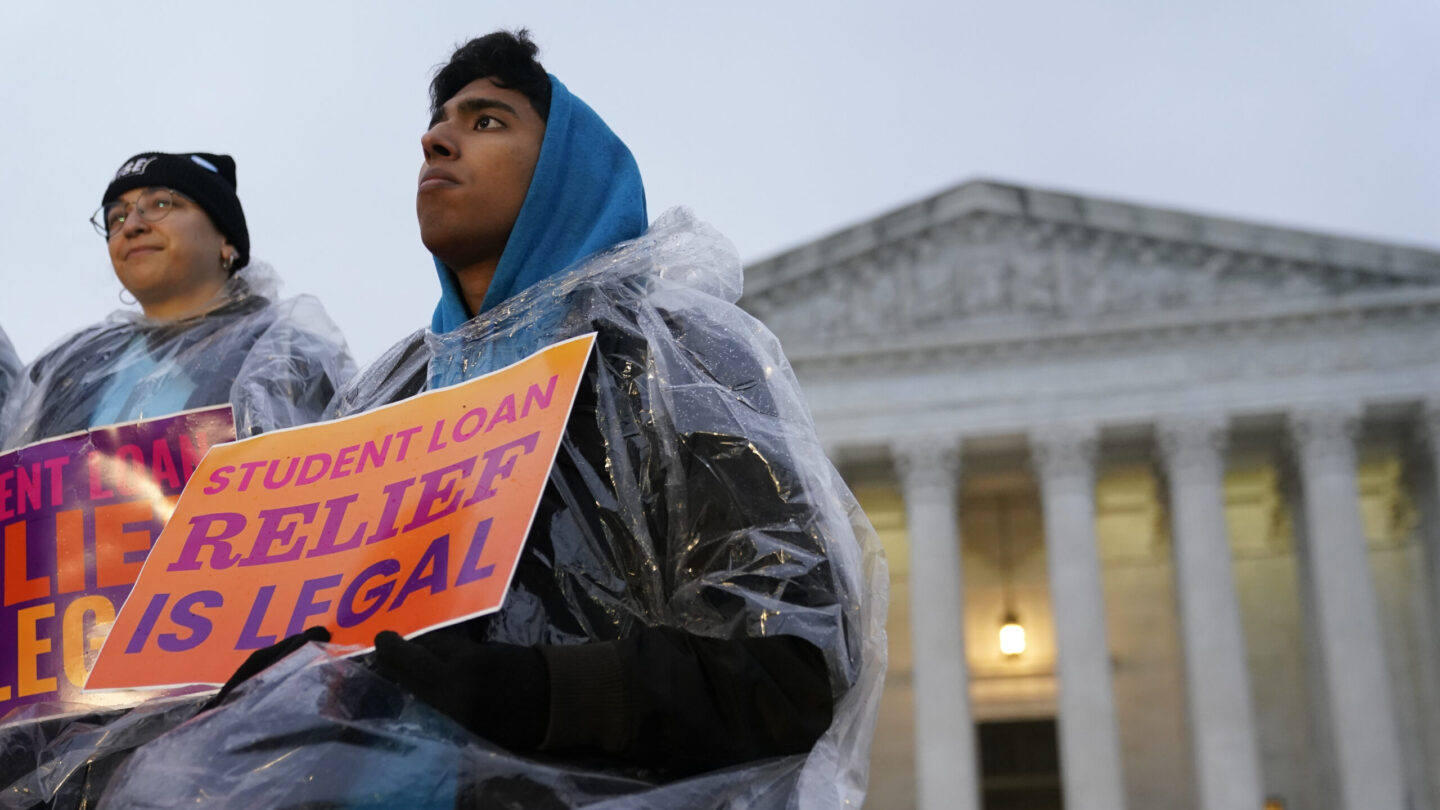A handful of Republican-dominated states will ask the Supreme Court on Tuesday to permanently block the Biden administration’s student loan forgiveness program. The states contend that the president exceeded his legal authority when he implemented a program to cancel up to $20,000 in debt for people holding federal student loans.
While the Biden administration is aggressively defending the program in court, the president did not announce the program until August 2022, and then only under pressure from the left wing of his own party.
Ultimately, the administration concluded that it did have the authority to enact such a loan forgiveness plan under a law called the HEROES Act. Passed by Congress after the 9/11 attacks, the law is meant to ensure that federal student loan borrowers will not be economically clobbered in a national emergency, or a war or disaster. The law specifically says that when the president declares such an emergency, the secretary of education has the power to “waive or modify any statutory or regulatory provision” governing student loan programs.
During the pandemic, the Trump and Biden administrations both invoked the law to pause student debt payments without penalties.
The Biden plan goes further; it provides economically disadvantaged borrowers can qualify for as much as $20,000 in cancellation of their student debt. Those earning more money, up to $125,000, could qualify for as much as $10,000 in debt relief. Already, 16 million student loan borrowers have been approved for some loan forgiveness, 90% of them earning less than $75,000, according to the administration.
The Biden plan, however, has not yet paid out any money because two lower courts have put the program on hold, sending the case to the Supreme Court. On Tuesday, the justices will hear expedited arguments in a challenge to the Biden plan brought by six states—Missouri, Nebraska, Iowa, Arkansas, Kansas and South Carolina.
The legal argument
The merits of the case are fairly straightforward. Does the 2003 law, known as the HEROES Act, give the president and his secretary of education the power to authorize federal student loan forgiveness?
Yes, says University of Texas law professor Stephen Vladeck, who consulted informally with the White House on the case. He says the words of the statute are clear and expansive.
“This is a stunningly broad grant of authority from Congress to the secretary of education,” Vladeck says. The plain text of the statute is “not vague when it talks about the secretary’s power to waive or modify any statutory or regulatory provision applicable to programs like federal student aid.”
But Case Western University law professor Jonathan Adler says waiving or modifying loan requirements is not the same thing as canceling the obligation to pay back some or all of a loan.
Adler concedes the statute’s language is broad, but he says it is likely not explicit enough for the very conservative Supreme Court of today.
“It’s certainly fair to claim that the court is putting a thumb on the scale in the way that statutory language like this is being interpreted,” Adler says, adding that the court, when in doubt, assumes Congress didn’t give any agency the power. “If we have to argue about, well, we read the statute this way or we read the other, the Department of Education has already lost,” he says.
Far-reaching consequences
Whichever way the court rules, its decision will have huge practical effects for millions of people with outstanding federal student loans, particularly borrowers who have lower incomes.
That said, the case could have an even greater impact if the justices decide that the states don’t have the right to sue at all because they can’t show they have suffered any concrete harm.
In recent years, Republicans have repeatedly parlayed state lawsuits into a forceful tool to get the conservative court to block the Biden administration’s policies. Democrats have used the tactic, too, though less successfully.
The number of these lawsuits is skyrocketing, and it is at least possible that the Supreme Court would like to see fewer of them. To do that, though, they would have to limit the doctrine of legal standing as it has been interpreted lately.
Legal standing means that to get in the courthouse door, a state has to show that its citizens have been harmed in some concrete way. The question in this case is whether any of the states have shown that.
“As a general matter, it is much harder to challenge a governmental action that does something nice for somebody else than a governmental action that harms you,” professor Adler observes. So the states have had to be “creative in terms of figuring out how to identify an impact on them from the forgiving of student loans to other people.”
Who is injured?
Indeed, the six states that are challenging the Biden plan have thrown everything at the wall to make such a showing. The two individual plaintiffs, for instance, would not qualify for loan forgiveness under the Biden plan. The one argument that Adler thinks likely may hold water is Missouri’s claim that the Biden plan could end up depriving the state of revenue from the Missouri Higher Education Loan Authority, known as MOHELA.
MOHELA is an independent corporation that has explicitly said it is not involved in the state’s challenge. But it is a state-created entity that is one of the largest holders and servicers of student loans in the country. The state of Missouri claims that because MOHELA would lose servicing fees on federal loans that are discharged, the agency might fail to make its required payments to the state treasury.
Professor Vladeck thinks that won’t fly because it it purely speculative. He points to what the Supreme Court has said for a decade—that a “future injury can’t be the basis to sue unless it is, in the words of Justice Samuel Alito, ‘certainly impending.'”
All of this may sound like “How many angels can dance on the head of a pin?” But if the court says the states don’t have standing to sue because they have not suffered any concrete harm, Biden’s loan forgiveness plan will go into effect, and an estimated 43 million borrowers with federal student loans will get some relief. The price tag, according to the Congressional Budget Office, would be $300 billion over a ten-year period.
Also likely to come up at Tuesday’s argument is the timing for student loan forgiveness. After all, the premise of the loan program is that younger people with loans, in particular, have suffered economically during the pandemic, and are in desperate need of some loan relief. But Biden has announced that the pandemic emergency will end May 11. The administration claims that the “downstream effects” of the pandemic will nonetheless continue for quite some time after the end of the emergency. At minimum, though, that argument could find some stiff headwinds at the Supreme Court.
Copyright 2023 NPR. To see more, visit https://www.npr.org.
9(MDAxODM0MDY4MDEyMTY4NDA3MzI3YjkzMw004))

9(MDAxODM0MDY4MDEyMTY4NDA3MzI3YjkzMw004))








